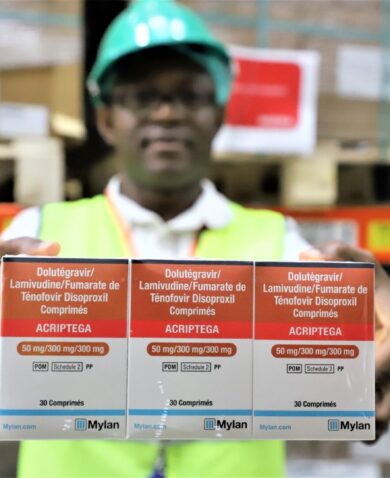
Chemonics News
News: Progress on the USAID Global Health Supply Chain Program – Procurement and Supply Management Project
November 16, 2017 | 3 Minute ReadWhile on-time deliveries under GHSC-PSM initially lagged, the numbers have improved significantly, as the project continues to provide life-saving commodities in nearly 60 countries worldwide.
The Global Health Supply Chain Program – Procurement Supply Management (GHSC-PSM) project is a large investment from the U.S. government in its mission to ensure people have access to critical health commodities. Recent news articles have reported on interest from Congress and the Inspector General (IG) on GHSC-PSM’s performance. Chemonics respects and welcomes IG and Congressional oversight and interest in the project. Both Congress and the IG plays a vital role in ensuring U.S. taxpayer dollars are used responsibly and effectively.
“Chemonics is fully committed to the success of this critical initiative,” says Chemonics President and CEO Susanna Mudge. “The investments and changes made this past summer have laid the foundation for the project to meet the high standards we set for ourselves, and which we owe to our client and the communities we serve. We stand ready to work with Congress, the IG and others to respond to any questions or concerns they may have.”
No patients have missed treatment because of GHSC-PSM’s late deliveries
Making sure patients have the life-saving medications they need when they need them is central to our mission. It is why we sought to work on this complex but critical project. In any global supply chain, late deliveries are the most complex and often unpredictable aspect of international shipping. Many situations can lead to late deliveries, from civil unrest to global shortages to hurricanes.
But when people’s health is on the line, we cannot settle for delays, no matter how unavoidable. To offset the risk of late deliveries, the U.S. government and other international donors have designed the global health commodity supply chain system to withstand these uncertainties. For instance, the system is designed with reserves for commodities. In most cases, even with a late delivery, there is typically at least 3 months of supply of any given commodity in-country to fill gaps created by late deliveries. There are also multiple large global health supply chains operating in addition to PSM, and these teams work together to prevent stockouts at the facility level.
Because of these safeguards and following a rigorous and extensive analysis, we have found no evidence that patients are going without medicine because of GHSC-PSM. Targeted analysis of late HIV/AIDS orders shows that most reported stockouts were limited to the central warehouse, and adequate stocks remained at provincial warehouses or clinics, pharmacies, and hospitals. GHSC-PSM continues to prioritize these deliveries to ensure no patient goes without treatment.
GHSC-PSM’s on-time delivery rate has improved dramatically
GHSC-PSM has committed to an on-time delivery rate of 60 percent by December 2017, and to consistently deliver 80 percent on time shortly thereafter. In fact, ongoing data validation shows that the project exceeded 60 percent OTD in October. And GHSC-PSM has done so using a three-week window as the definition of “on time,” whereas the previous projects had windows of four or even eight weeks for their orders to be considered on time.
“The 7 percent OTIF reported in the second quarter of 2017 was not acceptable to us, which is why we made significant management changes. These changes began immediately once we recognized the issue,” said Chemonics Executive Vice President and Acting GHSC-PSM IDIQ Director Jamey Butcher.
“While our on-time performance is often compared to the performance of previous projects, the comparison is not really valid. In fact, we’ve taken on more stringent performance standards including a narrower window of time for on-time deliveries. When we compare our current performance against the performance of previous projects using these more stringent standards, we believe that we’re now operating above their average on-time results. Having said this, we’re still not satisfied and believe we will shortly achieve and sustain on-time delivery results that are comparable to commercial standards through the remainder of this project.”
Since accurately measuring the delivery of commodities is essential to a well-functioning supply chain system, Chemonics has agreed with USAID to adopt the standard of On-Time Delivery (OTD) in addition to OTIF as dual measures of performance to be fully transparent and clear about the project’s progress. Using OTD as a measure will allow the project to provide real-time updates on delivery, which is impossible using only OTIF.
GHSC-PSM is delivering tremendous impact globally
Though the metrics of the global supply chain are a critical measure of GHSC-PSM impact, there is a great deal of impact occurring throughout the project. Because of GHSC-PSM’s scale, it can reduce costs by negotiating contracts that lower prices while maintaining supplier interest in the market, optimize warehousing to shorten shipping routes, adopt an efficient and agile approach to shipping commodities, buy more commodities from in-country suppliers, and help national supply chains introduce efficiencies. With less money spent on procurement and logistics, the project has the potential to reach many more people. For instance, by optimizing regional distribution centers, GHSC-PSM will save an estimated $38 million over six years. Further, one of the greatest challenges for in-country supply chains, which are most often not managed by GHSC-PSM, is data transparency. In Malawi, Madagascar, and Mozambique, GHSC-PSM is working with health ministries, health facilities, and supply chain managers to develop innovative LMIS solutions that are providing unprecedented visibility into in-country logistics and supply planning. Using these initial activities to test possible solutions, GHSC-PSM’s global reach has the potential to scale these innovations worldwide.
























